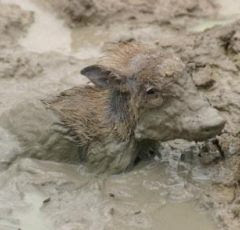Happy Cow, Happy Huumans
The only really consistent numbers are those from the feedlots where it's generally agreed it takes 7 kilograms of grain to produce just 1 kilogram of meat and nearly 40 percent of world grain is being fed to livestock rather than being consumed directly by humans.
Of course, these ratios are just one small aspect of the bigger picture, and though this gets lots of ink, many other aspects are just as important IMO. On an individual level the health benefits of grass-fed and free range meat and dairy products is indubitable. Meat, eggs, and dairy products from pastured animals are ideal for your health. Compared with commercial products, they offer you more "good" fats, and fewer "bad" fats. They are richer in antioxidants; including vitamins E, beta-carotene, and vitamin C. Furthermore, they do not contain traces of added hormones, antibiotics or other drugs.
Then there's water usage. "Grain-fed beef production takes 100,000 liters of water for every kilogram of food. Raising broiler chickens takes 3,500 liters of water to make a kilogram of meat. In comparison, soybean production uses 2,000 liters for kilogram of food produced; rice, 1,912; wheat, 900; and potatoes, 500 liters." - Cornell University.
Greenhouse gases? According to the UN Food and Agriculture Organization, emissions associated with livestock industries account for 14.5 percent of human-caused greenhouse gases.With 25 percent of the earth's land surface dedicated to grazing, and the planet hosting an 3.6 billion ruminant livestock, "greenhouse gas emissions from cattle and sheep production are up to nearly 50 times higher, on the basis of pounds of food produced, than they are from producing protein-rich plant foods such as beans, grains, or soy products."
Chemical fertilizers: Industrial meat production accounts for 80% of the nitrogen and phosphorus used in farming. On top of that, the intense run-off of nutrient-infused animal waste at large-scale meat manufacturing facilities contributes significantly to fertilizer pollution in bodies of water. Feed for free rangers consumes zero chemical fertilizers as well as zero fertilizer pollution in bodies of water.
The costs of livestock reared on heavily resource and pollution causing grain-fed production are as often as possible externalized onto the next generation, like all corporate schemes, through the degradation of the air, water and land that our descendants will inherit.
As Guy McPherson says at Nature Bats Last, "Cattle wreak havoc on soil via several avenues, most notably by compacting soil, removing organic matter, increasing runoff, and decreasing infiltration and percolation of precipitation. The wreaking of havoc is not restricted to soil, but instead extends to other organisms. Exactly nada zilch none zip bupkiss zero species native to North America evolved in the presence of cattle. Don’t even get me started on the completely irrelevant comparison between bison and cattle, two species with disparate behavior, diet, and morphology."
Not Happy Cows, Not Happy Humans
The next few Mud Reports will focus on the environmental impact - the hoofprints - of livestock raised by different methods as well as the diseases these cousins of ours suffer because of our lust for short term profit. We'll look at how free range grazing on perennial grasslands can turn a huge problem into a solution to the world food crisis and the environmental crisis including greenhouse gas pollution.




